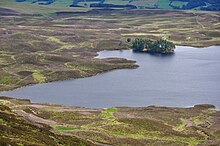Loch
 From Wikipedia - Reading time: 6 min
From Wikipedia - Reading time: 6 min

Loch (/lɒx/ LOKH) is a word meaning "lake" or "sea inlet" in Scottish and Irish Gaelic, subsequently borrowed into English. In Irish contexts, it often appears in the anglicized form "lough".[1] A small loch is called a lochan.
Lochs which connect to the sea may be called "sea lochs" or "sea loughs". Some such bodies of water could also be called firths, fjords, estuaries, straits or bays.
Background
[edit]



This name for a body of water is Insular Celtic[2] in origin and is applied to most lakes in Scotland and to many sea inlets in the west and north of Scotland. The word comes from Proto-Indo-European *lókus ('lake, pool'), and is related to the Latin lacus ('lake, pond'), English lay ('lake') and French lac, as well as the Italian, Portuguese and Spanish word for a lake, lago.[citation needed]
Lowland Scots orthography, like Scottish Gaelic, Welsh and Irish, represents /x/ with ⟨ch⟩, so the word was borrowed with identical spelling.[citation needed]
English borrowed the word separately from a number of loughs in the previous Cumbric language areas of Northumbria and Cumbria. Earlier forms of English included the sound /x/ as ⟨gh⟩ (compare Scots bricht with English bright). However, by the time Scotland and England joined under a single parliament, English had lost the /x/ sound. This form was therefore used when the English settled Ireland. The Scots convention of using ⟨ch⟩ remained, hence the modern Scottish English loch.[citation needed]
In Welsh, what corresponds to lo is lu in Old Welsh and llw in Middle Welsh (such as in today's Welsh placenames Llanllwchaiarn, Llwchwr, Llyn Cwm Llwch, Amlwch, Maesllwch), the Goidelic lo being taken into Scottish Gaelic by the gradual replacement of much Brittonic orthography with Goidelic orthography in Scotland.[citation needed]
Many of the loughs in Northern England have also previously been called "meres" (a Northern English-dialect word for "lake", and an archaic Standard English word meaning "a lake that is broad in relation to its depth"), similar to the Dutch meer, such as the Black Lough in Northumberland.[3] However, reference to the latter as loughs (lower case initial), rather than as lakes, inlets and so on, is unusual.
Some lochs in Southern Scotland have a Brythonic, rather than Goidelic, etymology, such as Loch Ryan, where the Gaelic loch has replaced a Cumbric equivalent of Welsh llwch.[4] The same is, perhaps, the case for bodies of water in Northern England named with 'Low' or 'Lough', or else represents a borrowing of the Brythonic word into the Northumbrian dialect of Old English.[4]
Although there is no strict size definition, a smaller loch is often known as a lochan (spelled the same also in Scottish Gaelic; in Irish, it is spelled lochán).[citation needed]
Perhaps the most famous Scottish loch is Loch Ness, although there are other famous ones, such as Loch Awe, Loch Lomond and Loch Tay.[citation needed]
Examples of sea lochs in Scotland include Loch Long, Loch Fyne, Loch Linnhe, and Loch Eriboll. Elsewhere in Britain, places like the Afon Dyfi can be considered sea lochs.[citation needed]
Uses of lochs
[edit]Some new reservoirs for hydroelectric schemes have been given names faithful to the names for natural bodies of water. For example, the Loch Sloy scheme and Lochs Laggan and Treig (which form part of the Lochaber hydroelectric scheme near Fort William). Other expanses are simply called reservoirs, e.g. Blackwater Reservoir above Kinlochleven.[citation needed]
Scottish lakes
[edit]Scotland has very few bodies of water called lakes. The Lake of Menteith, an Anglicisation of the Scots Laich o Menteith meaning a "low-lying bit of land in Menteith", is applied to the loch there because of the similarity of the sounds of the words laich and lake. Until the 19th century the body of water was known as the Loch of Menteith.[5] The Lake of the Hirsel, Pressmennan Lake, Lake Louise and Raith Lake are man-made bodies of water in Scotland, referred to as lakes.
Lochs outside Scotland and Ireland
[edit]As "loch" is a common Gaelic word, it is found as the root of several Manx place names.[citation needed]
The United States naval port of Pearl Harbor, on the south coast of the main Hawaiian island of Oʻahu, is one of a complex of sea inlets. It contains three subareas called 'lochs' named East, Middle, and West[6] or Kaihuopala‘ai, Wai‘awa, and Komoawa.[7]
Loch Raven Reservoir is a reservoir in Baltimore County, Maryland.
Brenton Loch in the Falkland Islands is a sea loch, near Lafonia, East Falkland.
In the Scottish settlement of Glengarry County in present-day Eastern Ontario, there is a lake called Loch Garry.[8] Loch Garry was named by those who settled in the area, Clan MacDonell of Glengarry, after the well-known loch their clan is from, Loch Garry in Scotland. Similarly, lakes named Loch Broom, Big Loch, Greendale Loch, and Loch Lomond can be found in Nova Scotia, along with Loch Leven in Newfoundland, and Loch Leven in Saskatchewan.
Loch Fyne is a fjord in Greenland named by Douglas Clavering in 1823.
See also
[edit]References
[edit]- ^ "lough". Oxford English Dictionary (Online ed.). Oxford University Press. doi:10.1093/OED/8929108233. (Subscription or participating institution membership required.)
- ^ The current form has currency in the following languages: Scottish Gaelic, Irish, Manx, and has been borrowed into Lowland Scots, Scottish English, Irish English and Standard English.
- ^ Beckensall, Stan (2004). Northumberland Place-Names. Thropton, Morpeth, Northumberland: Butler Publishing. ISBN 978-0-946928-41-5.
- ^ a b Alan, James. "Brittonic Language In The Old North - A Guide To Place Name Elements" (PDF). Archived from the original (PDF) on 13 August 2017. Retrieved 29 July 2018.
- ^ "Lake of Menteith | Scotland's Only Lake | Trossachs.co.uk".
- ^ "Pearl Harbor Ablaze Again: The West Loch Disaster". public2.nhhcaws.local. Retrieved 7 November 2024.
- ^ "Pearl Lochs". Images of Old Hawaiʻi. 15 March 2024. Retrieved 7 November 2024.
- ^ "Lochgarrylakeassociation - LGLA Action". Archived from the original on 20 October 2013. Retrieved 15 June 2012.
 KSF
KSF